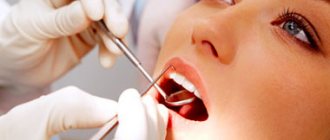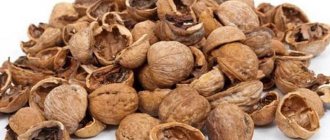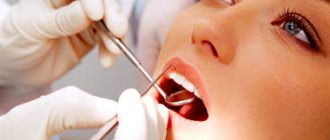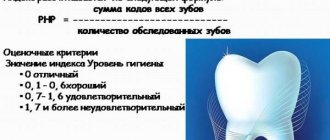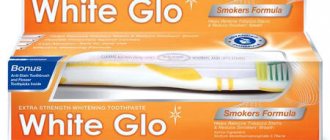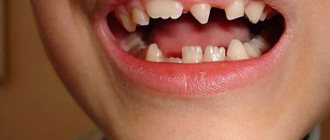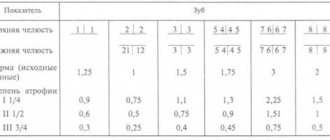The formula will help determine the condition of the mouth
To determine the condition of the oral cavity in medicine, there are about 80 different hygiene indices, based on the principle of staining the enamel with a special solution and identifying dental plaque.
According to the parameters they define, indices can be classified into 4 groups, assessing:
- area affected by plaque;
- thickness of plaque on teeth;
- mass of plaque;
- other parameters of dental plaque (chemical, physical and microbiological).
conclusions
Periodontal indices provide information about the hygienic state of the periodontal tissue, the intensity and prevalence of inflammation and destruction in periodontal tissues.
Examinations allow a preliminary assessment of the general condition of the periodontium and make a conclusion about the effectiveness of therapeutic and hygiene products.
If you find an error, please select a piece of text and press Ctrl+Enter.
Tags gums treatment periodontal indices periodontal disease
Did you like the article? stay tuned
Previous article
The subtleties of returning the original shade to a tooth using intracanal whitening
Next article
Features of teeth whitening with Double White products
CPU in dentistry
Dentists should use these calculations during the initial examination of the patient. So, for example, the average values of the indices KPU, kp. KPU+KP of teeth and cavities in dentistry allows you to determine the intensity of carious lesions. These abbreviations contain the following meanings:
- K – carious permanent teeth;
- P – permanent teeth in which a filling is installed;
- U – extracted molars;
- j – temporary teeth affected by caries;
- p – filled temporary teeth.
- According to the World Health Organization, the average CP index for children 12 years old should be from 2.7 to 4.4, and for citizens aged 35-44 years 6.3-12.7.
Quality and safety
I, the subject of personal data, in accordance with the Federal Law of July 27, 2006 No. 152 “On Personal Data,” provide SCNT “NOVOSTOM” LLC: (hereinafter referred to as the Operator), located at 127030 Moscow, st. Novoslobodskaya, 24, building 4 (checkpoint 770701001), consent to the processing of personal data specified by me in the registration form and/or in the feedback form on the Internet site, owned by the Operator.
The personal data I provide is as follows: full name, email address and telephone number.
The purposes of processing my personal data are: ensuring the exchange of short text messages in online dialogue and ensuring the functioning of a call back.
Consent is provided to carry out the following actions (operations) with the personal data specified in this consent: collection, systematization, accumulation, storage, clarification (updating, changing), use, transfer (provision, access), blocking, deletion, destruction, carried out as with using automation tools (automated processing) and without the use of such tools (non-automated processing).
I understand and agree that providing the Operator with any information about myself that is not contact information and not related to the purposes of this consent, as well as providing information related to state, banking and/or commercial secrets, information about racial and/or nationality, political views, religious or philosophical beliefs, health status, intimate life are prohibited.
If I decide to provide the Operator with any information (any data), I undertake to provide only reliable and up-to-date information and do not have the right to mislead the Operator regarding my identity, or provide false or inaccurate information about myself.
I understand and agree that the Operator does not verify the accuracy of the personal data provided by me and is not able to assess my legal capacity and assumes that I provide reliable personal data and keep such data up to date.
Consent is valid upon achievement of the purposes of processing or in the event of the loss of the need to achieve these purposes, unless otherwise provided by federal law.
Consent may be withdrawn by me at any time based on my written statement.
Simplified index (IGR-U)
The Green Vermillion Hygiene Index measures plaque and tartar on the surfaces of the 2 upper first molars, 2 lower first molars and 2 upper incisors.
Ratings are given as follows:
- 0 – no plaque;
- 1 – no more than 1/3 of the tooth surface is covered with plaque;
- 2 – plaque affects from 1/3 to 2/3 of the tooth;
- 3 – dental plaque covers more than 2/3 of the surface.
The simplified hygienic index is calculated by adding the plaque index and tartar index on 6 teeth.
General overview
Periodontal indices are a quantitative (in percentage or coefficients) expression of pathological processes occurring in the periodontium.
In comparison with clinical diagnostic methods, the index assessment is relative and does not claim absolute accuracy.
However, it has a number of advantages that clinical diagnostics lack. With its help it is convenient:
- conduct epidemiological studies for any segment of the population;
- monitor the dynamics of pathological processes;
- compare the results of different studies;
- evaluate the effectiveness of treatment and prevention.
PMA – papillary-alveolar-marginal index
When calculating the PMA index, a solution of iodine or Lugol is used, which is applied to the gums and the degree of tissue inflammation is determined by the reaction to the irritant.
The evaluation criteria are:
- 1 – if the papilla (P) is inflamed;
- 2 – in case of inflammation of the marginal edge (M);
- 3 – inflammation of the alveolar part of the gum (A).
Formula RMA = Sum of points/n*3 (in percentage), where n is the number of teeth (up to 6 years – 20 teeth; 6–12 years – 24 teeth; 12-14 years – 28 teeth; over 15 years – 30 teeth) .
If the value is less than 30%, then the degree of damage is mild, 31-60% is moderate, 61% or more is severe.
Periodontal index (PI).
To study the prevalence and intensity of periodontal tissue damage, the periodontal index (PI), developed by Russel (1956), is currently widely used.
The periodontal condition of each tooth is determined by a score from 0 to 8, taking into account the degree of gum inflammation, tooth mobility, and the depth of the periodontal pocket. In doubtful cases, the lowest possible rating is given (Table 9.2). All estimates are added up and divided by the number of teeth present. The resulting PI is assessed as follows: 0.1 - 1.0 - initial and stage I of the disease; 1.5—4.0—presence of destructive changes characteristic of stage II of the disease; 4.0—8.0—stage III of the disease. Table 9.2. Periodontal Index (PI)
Rating Clinical signs 0 No inflammation 1 Mild gingivitis - there is inflammation, but it does not involve the entire tooth 2 Gingivitis - inflammation completely surrounds the tooth, but there is no damage to the epithelial attachment 6 Gingivitis with pocket formation - the epithelial attachment is damaged, there is a periodontal pocket, There is no impairment of the chewing function of the tooth, the tooth is not damaged 8 Severe destruction of periodontal tissues with loss of chewing function, the tooth is easily mobile, can be displaced
In addition to PI, the condition of periodontal tissues can be taken into account using the papillary-marginal-alveolar index (PMA). The PMA index can only be used to study initial changes in the periodontium; that is why it is called the gingivitis index. Inflammation of the papilla (P) is assessed as 1, inflammation of the gingival margin (M) - 2, inflammation of the alveolar gingiva (A) - 3. The digital value of the PMA index is the sum of indicators of the condition of the marginal periodontium of all existing teeth and is always expressed as an integer. Parma (1960) proposed his modification of the PMA index to express its value as a percentage. The Parma PMA index is calculated (as a percentage) as follows: Gingivitis index = Sum x 100 / 3 x number of teeth
The sum is obtained by adding all the highest scores for the marginal periodontal condition of each tooth; at the same time, the number of teeth at the age of 6 to 11 years is taken to be 24, from 12 to 14 years - 28; from 15 years old - 30. To assess the hygienic state of the oral cavity, a number of indices have also been proposed [Fedorov Yu.?., Volodkina V.V., 1964; Greene, Vermillion, 1960]. The hygienic condition of the oral cavity, as well as its dynamics, is assessed using the Fedorov-Volodkina hygiene index as follows. The vestibular surfaces of 3 2 11 12 3 teeth are lubricated with Schiller-Pisarev solution. Depending on the amount of plaque, different areas of the tooth surface are stained with different intensities. Coloring is assessed quantitatively and qualitatively. Quantitative assessment (Ksr) is carried out according to a five-point system: staining of the entire surface of the crown - 5 points, 74 - 4 points, '/2 - 3 points, '/4 - 2 points, absence of staining - 1 point. The calculation is made using the formula:
Ksr = Kn/n
where Ksr is the quantitative hygienic index; Kp is the sum of index values for all teeth; ? - number of teeth (6). Normally, the hygienic index should not exceed one. Quantitative assessment of plaque intensity can be carried out using a three-point system: intense staining of the tooth surface - 3, weak - 2, lack of staining - 1. The calculation is made using the formula:
Sav = Sn / n
where Scp is the hygienic index of the intensity of dental plaque; Sn is the sum of index values for all teeth; ? - number of teeth (6).
Php Index
Scientists Podszadlej and Haley developed an oral hygiene performance index. First, a dye solution is applied to the teeth, then the patient rinses his mouth with water, and 6 teeth are examined. In this case, their surface is divided into 5 sections: medial, distal, mid-occlusal, central, mid-cervical. The absence of staining is determined by zero, and the presence - by one.
When calculating, use the formula: IG = ZN/n, where ZN is the sum of codes for all teeth; n – number of teeth examined. With a value of 0, the condition of the oral cavity is considered excellent, and with a value of 1.7 or more, it is considered unsatisfactory.
Stages of epidemiological survey according to WHO
The purpose of the survey: to determine the prevalence and intensity of caries.
The examination consists of 3 stages.
Preparatory
Research groups are formed from doctors who have mastered the examination technique. Population populations are determined (depending on the survey objective) and group sizes (depending on the required accuracy of the results).
It is desirable to have an equal number of female and male representatives in the group, as well as to provide all possible options regarding external factors, social status, and ethnicity of the subjects.
Survey
It is made on the basis of a registration card developed by WHO in 1986. A simplified form is available for children under 15 years of age.
Evaluation of results
Two parameters are assessed that characterize the position of units with caries - prevalence and intensity.
The prevalence of caries can be:
- high – at 50-70%:
- mass – at 70-90%;
- continuous – more than 90%.
The intensity of caries is determined depending on the CP of the elements of the jaw arch. “K” means “caries”, “P” means “filling”, “U” means “removed”. The sum of carious, filled and removed units (C+P+U) is calculated and the value of the intensity of the disease is assessed.
- It is considered low if the KPU does not exceed 3.0.
- Average - with KPU = 3.0-6.0.
- High – if the KPU is more than 6.0.
CPITN (periodontal disease treatment need index)
This method covers 10 teeth, allowing the dentist to see the condition of the gums of the upper and lower jaws. Grades are given as follows:
- 0 – no disease symptoms;
- 1 – gums are bleeding;
- 2 – tartar was found above and below the gum;
- 3 – gum pocket 4-5 mm deep;
- 4 – gum pocket more than 6 mm.
It may come as a surprise to many that the condition of teeth can be determined using a formula, but this is the truth. Therefore, do not neglect maintaining oral hygiene, so as not to be a poor student in this calculation.
The iOrtho clinic network provides high-quality services for correcting malocclusion with Invisalign aligners, sign up for a consultation now!
